
Drones, or Unmanned Aircraft Systems (UAS), were developed for war. The idea was first conceived in World War I and they were first adopted for surveillance purposes at the end of World War II and in the Korean and Vietnam Wars. Then military drones like the Predator became armed during the “Global War on Terror.”
For many years now, people in war zones like Iraq and Afghanistan have had to assume that they were being tracked by a drone they could not see, circling miles over their heads. In the United States, government and corporate surveillance is everywhere. However, other than isolated exceptions like the Predator circling over Minneapolis during the George Floyd protests, military drones have not been allowed to operate in civilian, or “non-segregated,” U.S. airspace. That is about to change.

With very little public notice, the U.S. government started the process of opening U.S. civilian airspace to military drones (otherwise known as “integration”) in 2010. The Department of Defense (DoD) and the Department of Transportation began drafting a “Plan,” at the direction of Congress, and that Plan was signed into law by Barack Obama in 2012.
The Plan emphasized Federal Aviation Administration (FAA) steps to integrate “civil” (civilian, commercial, hobbyist) drones into the National Airspace System (NAS). But the short section devoted to “public” (government, military) drones served the original purpose—beginning the opening of U.S. skies to routine operation of Predators, Reapers, and other drones. A plan within a Plan.
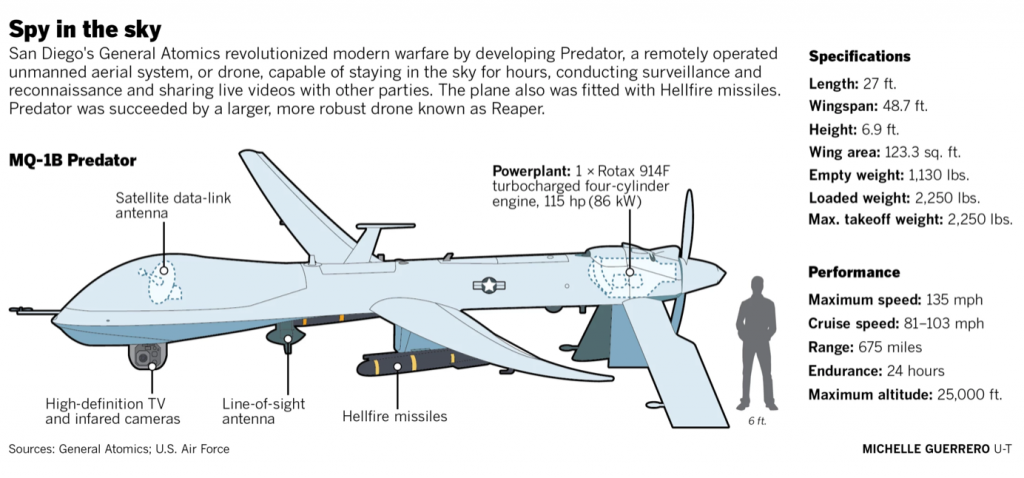
Since then, it has become clear that there was another plan within this Plan. It involved using the imprimatur of the FAA to push the next generation of U.S.-made surveillance/attack drones onto U.S. allies across the globe—not all of whom were deemed suitable to receive advanced U.S. drones previously. Countries with a history of human rights violations [like Morocco or the United Arab Emirates (UAE)], or perpetual states of conflict with their neighbors (like India or Taiwan) have not been able to acquire the most advanced U.S.-made drones. Those restrictions are now falling away.
One U.S. drone maker was at the center of the effort from the start: General Atomics (GA). Maker of the Predator, and then the Reaper, its newest, most advanced drone is the MQ-9B SkyGuardian.

Originally called the “Ceritifiable Predator B,” GA started developing it in 2012 soon after the Plan was signed into law. As the name implies, it was designed from the ground up with the intention that it be certified to operate in domestic airspace. GA has been aggressively marketing it overseas since 2014, with the presumed certification by the FAA as a major selling point. (How aggressively? GA sued the German government to try to force it to reconsider choosing a competitor’s drone.)
GA funded this project internally, meaning it placed a gigantic bet that its “certifiable” drone would be warmly received by the FAA. If in fact there was prior coordination among the DoD, FAA and General Atomics, it suggests that a U.S. foreign policy initiative, a “Public-Private Partnership,” huge and unpublicized, was woven into this Plan.
Since it began in 2012, the majority of the reporting on the DoD/FAA’s drone integration program has been about the civilian/commercial benefits of small drone integration—package delivery, local law enforcement, infrastructure inspection, etc. But behind the scenes, integrating military drones appeared to be the main purpose. And then, there are the foreign sales.
“The foreign sales aspect of these RPAs is potentially huge.”

U.S. Air Force (USAF) Major General James O. Poss, Deputy Chief of Staff for Intelligence, Surveillance, and Reconnaissance, the senior Intelligence officer for the USAF, was quoted in a 2012 article titled “Military ‘Aggressively Working’ To Ease Drone Sales Abroad.” He stated that “the foreign sales aspect of these RPAs [remotely piloted aircraft] is potentially huge.… A less restrictive export policy for unmanned aircraft is “in the national interest of the United States,” Poss continued. “It’s something we’re aggressively working with both the OSD [Office of the Secretary of Defense] policy folks and the State Department.”
Two months after that article appeared, General Poss retired from the USAF. During his career he had, among other things, shepherded the Reaper drone through its certification in 2005. He was central to expanding the role of drones in Iraq and Afghanistan, and for touting their capabilities, like the new “Gorgon Stare” technology. Gorgon Stare and its successors allowed the USAF to maintain a constant, high-definition video database of a huge area, which could be searched at a later date.
“Gorgon Stare will be looking at a whole city, so there will be no way for the adversary to know what we’re looking at, and we can see everything.”
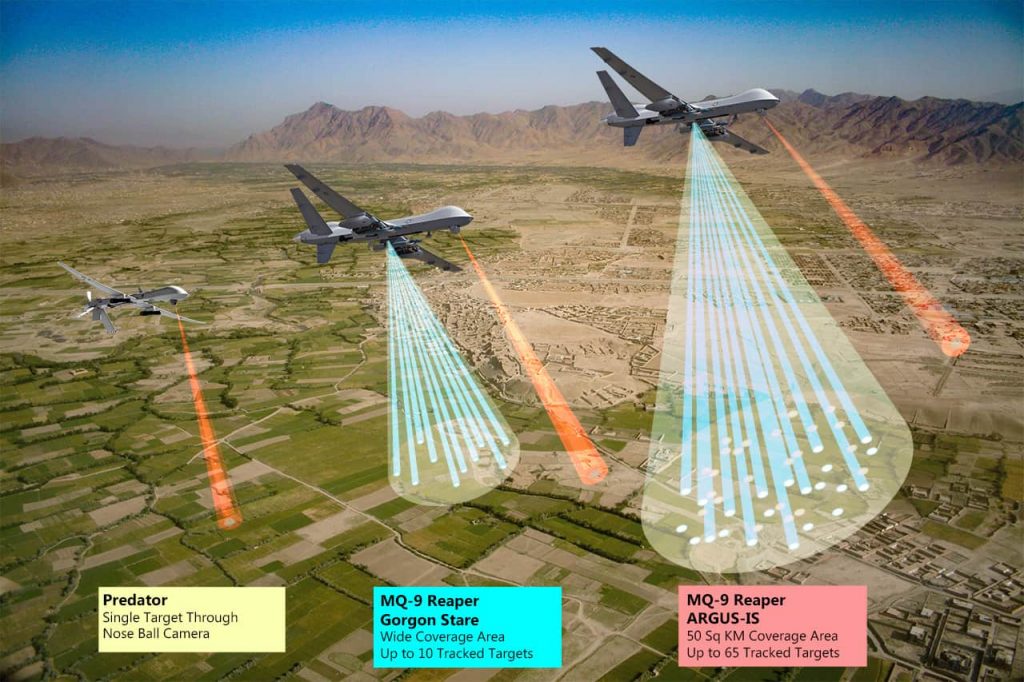
After leaving USAF, Poss was tapped by the FAA to direct research into integrating drones into domestic U.S. airspace. He was almost certainly one of the authors of the Plan.
While the choice of leadership of the FAA UAS Center of Excellence was billed by the FAA as a “rigorous competition,” Poss appeared to have known years in advance that he would be holding this office. In a January 2015 interview just before the choice was announced, he said “We’ve been preparing for this competition for over five years.” So that was, what—2010? From 2010 – 2012, Poss was still at the Pentagon.

The decision to place Poss in this office was likely made by the FAA Assistant Administrator for NextGen, the office that oversees all FAA Centers of Excellence. At the time, that position was held by former USAF Major General Edward L. Bolton, Jr., Director, Space and Cyber Operations. His role is especially interesting as GA was on a path to become a major player in the militarization of space.
Bolton and Poss were two of the dozens of former senior military officers occupying positions at FAA and ancillary organizations involved in drone integration.
General Poss again, from the 2012 article:
[T]here are international lawyers out there that think the various treaties dealing with cruise missiles apply,” such as the Missile Technology Control Regime (MCTR).
The MTCR was embraced by the U.S. in part to keep advanced drone technology from countries which were not solid allies of the U.S. Not that U.S. drone technology is unrepresented abroad. The Reaper drone is a major weapons system of many U.S. allies. (A man named Stephen Luxion was instrumental in providing the MQ-9A Reaper to U.S. allies. His name will come up again.)
Another of those likely Plan authors featured in that 2012 article was DoD official Steven Pennington. For the previous several years, he had been the principal public advocate of opening U.S. airspace to military drones.

“A senior Air Force civil servant put the stakes bluntly: ‘The aviation enterprise is the crown jewel in the U.S. economy by far. It has the greatest number of high value jobs, it has the greatest value that is exported,’ said Steven Pennington, director of ranges, bases and airspace. If the U.S. does not take the lead in the global drone market, he warned, Europe, Asia and others will ‘quickly fill that void.’
“Poss said, ‘The stakes are strategic as well as economic. The military sees foreign military sales of all kinds as a way to build relationships with friendly governments while equipping them with gear that makes it easier to operate alongside U.S forces. Unmanned air vehicles are a particularly important area to be interoperable.’”
Poss had been celebrated for his years as a leader of “interoperability” between the U.S. and United Kingdom (UK) airborne intelligence forces. If there is any evidence that the drone integration Plan had an international proliferation agenda within it, this was it.
When Poss left the USAF in late 2012, his senior Intelligence counterpart in the Royal Air Force (RAF), Sir Stephen Hillier, had left his position several months earlier, to oversee UK Ministry of Defense (MoD) military procurement. This would place him at the center of the decision whether to purchase the newest U.S.-made military drone, GAs MQ-9B SkyGuardian, for the UK’s “Protector” initiative. It was one of four career moves for Hillier in ten years, coinciding with steps that would lead to the MQ-9B operating in UK skies. Other steps are explained below.

On the last day of 2013, the FAA announced the winners of the coveted state-level UAS test sites mandated in the 2012 FAA Act, chosen after a supposedly rigorous competition. There was no mention of military activities. However, each site wound up being led by a high-level, recently retired military officer. In one case, North Dakota (ND), it was headed by the state’s active-duty Air National Guard Commander.
DoD official Pennington actually cited ND’s Grand Forks Air Force Base in a 2011 article about the DoD/FAA drone program, months before the legislation was signed into law. He also stated that the funding for these sites would come from the DoD, not FAA. While they would all go on to conduct some civilian, commercial drone integration research, the military leadership, funding and military bases they operated on or next to, signaled what their principal purpose was.
For example, a few years after its founding, it was difficult to see where the FAA’s “Northern Plains UAS Test Site” (NPUASTS), Grand Forks Air Force Base, and the large General Atomics facility next door begin and end. This was where the 2018 MQ-9B SkyGuardian flight over the Atlantic would depart from, on its PR mission to the UK’s Royal Air Force. It was timed to arrive for the Royal International Air Tattoo airshow, where the newest military aircraft are displayed for potential buyers.
DoD official Pennington, cited above, was quoted in February of 2012 that the DoD would be selecting these sites based on their criteria. The fiction that this was anything but a principally military research operation is pretty thin. In any case, the test sites would share in federal research grants disbursed by former Major General James Poss’s FAA UAS Center of Excellence, ASSURE.
By mid-March of 2016, the Unmanned Aircraft Systems Executive Committee (ExCom), created in 2009 to coordinate UAS activities among federal agencies, was expanded. It then included DoD, FAA, NASA, and the Departments of Commerce, Justice, and Interior. When NASA joined in 2010, it understood that the purpose of this coordination was to expedite public (military) UAS access to the NAS. The ExCom was chaired by former Major General Marke “Hoot” Gibson, previously Director of Operations, Deputy Chief of Staff for Operations for the USAF. At the time, he was the FAA’s “Senior Adviser on UAS Integration.” A two-star Air Force General would be representing the “civilian” FAA on a joint-agency committee overseeing drone integration.

The FAA also stated explicitly that the focus of the ExCom was “DoD’s UAS access into the NAS.” ExCom was originally named the “Joint Department of Defense and Federal Aviation Administration Executive Committee on Conflict and Dispute Resolution,” suggesting a history of conflict and disputes between the DoD and FAA on military drone integration which, according to the 2009 National Defense Authorization Act, posed “a threat to national security.”
At that same time, emails obtained in 2018 by DroneWarsUK revealed extensive coordination between the MoD, GA, USAF, and FAA to persuade skeptical UK civilian air regulators not to block the acquisition of the MQ-9B for the Protector Initiative. One thread of emails had the subject line “Developing the Mechanism for a Technical Support Arrangement to Protector.”
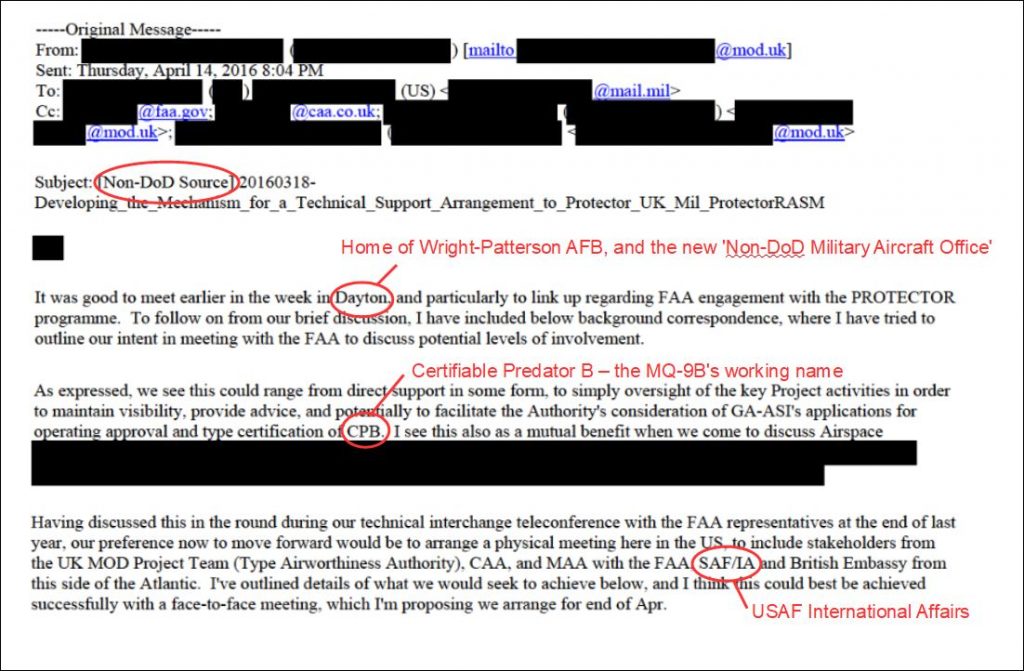
That is when, coincidentally, the USAF committed to opening a “Non-DoD Military Aircraft Office” (NDMAO) at Wright-Patterson AFB. It would be dedicated to providing certification services to U.S. companies producing military aircraft that the U.S. did not currently intend to purchase. These services would be provided to private companies for a fee. The email thread then had the words “[Non-DoD Source]” added to the subject line. MQ-9B SkyGuardian is the NDMAO’s first customer. The UK would eventually pay the bill.
It appears that did the trick. One month later, the UK announced it would buy the MQ-9B. Both James Poss and Stephen Hillier resigned their respective posts within weeks, strongly suggesting that the sale of the MQ-9B to UK was the reason they were in those posts to begin with. Hillier would go on to become Air Chief Marshal, Commander of the Royal Air Force. Poss would found his own UAS consulting company. Edward Bolton had left FAA a month earlier, to become a Vice President at the Aerospace Corporation, the private company that manages the launch and space systems of the USAF and the National Reconnaissance Office.
Poss’s successor at the FAA UAS COE was former USAF Colonel Stephen “Lux” Luxion. His career had two notable high points: He created and ran the first Predator attack unit tasked to the CIA in the “Global War on Terror,” the 17th Reconnaissance Squadron. (While this fact was originally included in his ASSURE bio, it has since been deleted.)
Later, when the Reaper was established as the drone of choice for U.S. allies, Luxion was stationed in Europe overseeing basing decisions for the new drone squadrons. It is an unexpected pedigree for the head of FAA research into integrating drones into civilian U.S. airspace, unless one considers that the goal may have been to place advanced U.S.-made drones into other countries airspace as well.

A few months later, in July of 2016, ExCom member NASA announced its UAS “Systems Integration and Operationalization” (SIO) flight demonstrations. Listed first in the missions of vital importance are “national security and defense.” However, when GA was later announced as one of the participants, the stated purpose of its flight would be to demonstrate potential civilian, commercial uses of large, military-grade drones. GA floated one civilian/commercial use of the MQ-9B on a defense industry news site: local law enforcement. In a surprisingly candid moment, the pro-industry reporter covering it called the idea “dystopian.” GA would eventually land on “infrastructure surveying” as a plausible commercial application of the $100 million, 6-ton, 79-foot wingspan MQ-9B.
A May 2017 presentation of NASA’s program on drone integration appeared to have the SIO demo flights scheduled for summer 2021 (page 23).
In June 2017, the Trump administration announced its intention to sell the “SeaGuardian” MQ-9B variant to India. For the U.S. to sell the MQ-9B to India would require “decoupling UAS from the MTCR.” A few months later, the Trump administration confirmed that it was “reviewing” the MTCR.
By October 2017, it appears that NASA’s SIO demo flights were moved up one full year to summer 2020 (page 19).
November 2017. General Atomics purchased the U.S. subsidiary of UK-based satellite maker Surrey Satellite Technology. GA is described as “a defense contractor with a growing interest in building military-optimized spacecraft.”
August 2018. NASA announced that General Atomics was one of the three companies selected to participate in its SIO demonstrations.
September 28, 2018. General Atomics Awarded NASA Contract for Commercial Satellite.
January 24, 2019. The UK’s MoD announced they would purchase the “Sense-and-Avoid” systems for their MQ-9B Protector drones, after the original contract omitted that option. The decision came after GA went around MoD and lobbied Parliament directly:
“[F]ailure to make appropriate provisions threatens to undermine Protector’s operational capability…One of the platform’s key design characteristics is provision for the sense-and-avoid capability required to facilitate operations in non-segregated airspace… MoD aspires to integrate such a sense-and-avoid system but it was not funded within the core program.”
August 2019. GA performed a test of the SkyGuardian in civilian U.S. airspace for the benefit of the RAF, U.S. Marine Corps, and Royal Australian Air Force. The USMC was the first U.S. military branch overtly interested in the MQ-9B. GA touted the FAA clearance for the flight, which occurred almost entirely over mountains and desert. A week later, James Poss penned an opinion piece applauding the UK’s purchase of the MQ-9B SkyGuardian, and urging the U.S. and all its allies to do the same, to prepare for a possible war with Iran. He claimed that the MQ-9B “can fly integrated with even civilian manned aircraft,” a statement which two years later, still is not exactly true.
October 7, 2019. GA announced the planned SIO demo flight over San Diego. There are numerous misleading statements in the announcement, such as City of San Diego participation, etc. The principal stated purpose of the demo was infrastructure inspection, although it would be revealed later by the Voice of San Diego (VOSD) that they were still secretly pitching law enforcement uses.
November 28, 2019. Seven weeks after the San Diego SIO announcement, Australia announced it was going to purchase the MQ-9B instead of the cheaper MQ-9A, specifically because “the MQ-9B is able to be certified to fly in civilian airspace,” again, not yet exactly true.
Mav 7, 2020. The UK announced that Sir Stephen Hillier would resign as Air Chief Marshal of the RAF, in order to take over the Civil Aviation Authority (CAA), just as it was grappling with whether to allow the MQ-9B to operate in UK airspace in the summer of 2021.
June 1, 2020. VOSD announced its lawsuit against the FAA for documents related to the proposed MQ-9B flight over the City. “We can’t get into details about a military aircraft program,” said the FAA. This, despite the fact that every aspect of the SIO flight stated publicly had been civilian: owner, operator, aircraft certification, airspace, sponsoring agency (NASA), stated purpose, etc.
July 9, 2020. GA informed Forbes that the SIO flight over San Diego was canceled.
July 24, 2020. The Trump administration officially changed how it “interpreted” the MTCR, clearing the way for military drone sales to countries that were previously excluded. New potential buyers of the MQ-9B soon included India, Taiwan, Morocco, and the UAE. Along with the confirmed sales to the UK, Belgium and Australia, it looked like MQ-9B sales would soon exceed $10 billion.
October 26, 2020. The VOSD released FOIA’d emails that showed the deep skepticism that FAA engineers had over the safety claims by GA. The proposed SIO flight over San Diego was eventually canceled, and replaced by a flight over non-populated areas. However, the specific reasons why it did so were redacted. Also, it is clear that FAA personnel were aware that GA would be using this supposed commercial demonstration flight to showcase the MQ-9B to foreign military buyers.
March 26, 2021. Reuters reported that the Biden administration was likely to keep the new MTCR policy.
May 2021. NASA released General Atomics final report on its SIO flight, which GA was required to generate in its SIO contract with NASA. It revealed that the critical safety component for avoiding other aircraft, the “Detect and Avoid” system, failed repeatedly during the flight, just as FAA engineers feared it would.
July 24, 2021. After fighting in court not to reveal the reasons for denying the proposed SIO flight over San Diego, the FAA agreed to answer a few more questions from the VOSD. In response to the question of “Whether General Atomics voluntarily rerouted its flight to the desert, or whether the FAA denied the permit,” its paragraph-long answer could be summarized as:
We never denied General Atomics a permit to fly the SkyGuardian over San Diego. We approved its permit to fly, just not over San Diego.
It is also fair to ask if the FAA was keeping the reasons for the San Diego denial under wraps so as to not embarrass GA. GA’s sales pitch to foreign customers was that the MQ-9B could be certified for domestic operations. Rejection by the FAA for a demo flight for which it had been preparing for many years might cause potential customers to think twice before committing to a multi-billion dollar weapons purchase.
July 28, 2021. After delaying the decision for months, the UK’s CAA (now headed by Sir Stephen Hillier, former Air Chief Marshal of the RAF) approved temporary airspace changes that would allow the MQ-9B SkyGuardian to operate in UK civilian airspace during the NATO “Joint Warrior” exercises. Joint Warrior is a major opportunity to demonstrate the MQ-9B to potential allied military customers. This was the exact same drone that was rejected by the FAA for a flight over the City of San Diego one year earlier.

September 8, 2021. In the middle of the Joint Warrior exercises, the MQ-9B appeared to detour to conduct “Contested Urban Environment” exercises over the UK Army’s Imber Range in southern England. It is not clear if it was part of the official CUE2021 exercise. Some 48 hours after the flight, the Chief of the Air Staff of the RAF announced that, when the Protector drone is operational, it will be available for “assisting local authorities.”
September 9, 2021. The RAF announced the creation of the “Protector International Training Centre” at the Waddington RAF base. That would be a MQ-9B pilot training facility for “international partners.”
General Atomics is becoming a major player in military space hardware construction, including winning a DARPA contract to design a nuclear reactor to power spacecraft to the moon.

A Freedom of Information Act request to see the report containing the Plan mandated in the 2010 NDAA was placed with the FAA in the spring of 2021. Nine months later, the FAA has yet to acknowledge receipt of the request.
The Plan appears to be: civilian drone integration is cover for military drone integration is cover for military drone proliferation. Underlying it all is the familiar argument for foreign military sales: If the U.S. does not do it first, others will. For decision-makers, this dovetails neatly with the economic and political rewards, leading to: Drone proliferation is a necessary good.
Apparently, we have no choice but to stay in the lead of the arms race we started. Rinse, repeat.
In the coming years, people in more and more countries (including the U.S. and its allies) will be wondering if a high-tech surveillance/attack platform is circling overhead, making a permanent record of everything they do once they set foot outside their homes. Is this the kind of “freedom” America should be exporting?

CovertAction Magazine is made possible by subscriptions, orders and donations from readers like you.
Blow the Whistle on U.S. Imperialism
Click the whistle and donate
When you donate to CovertAction Magazine, you are supporting investigative journalism. Your contributions go directly to supporting the development, production, editing, and dissemination of the Magazine.
CovertAction Magazine does not receive corporate or government sponsorship. Yet, we hold a steadfast commitment to providing compensation for writers, editorial and technical support. Your support helps facilitate this compensation as well as increase the caliber of this work.
Please make a donation by clicking on the donate logo above and enter the amount and your credit or debit card information.
CovertAction Institute, Inc. (CAI) is a 501(c)(3) non-profit organization and your gift is tax-deductible for federal income purposes. CAI’s tax-exempt ID number is 87-2461683.
We sincerely thank you for your support.
Disclaimer: The contents of this article are the sole responsibility of the author(s). CovertAction Institute, Inc. (CAI), including its Board of Directors (BD), Editorial Board (EB), Advisory Board (AB), staff, volunteers and its projects (including CovertAction Magazine) are not responsible for any inaccurate or incorrect statement in this article. This article also does not necessarily represent the views the BD, the EB, the AB, staff, volunteers, or any members of its projects.
Differing viewpoints: CAM publishes articles with differing viewpoints in an effort to nurture vibrant debate and thoughtful critical analysis. Feel free to comment on the articles in the comment section and/or send your letters to the Editors, which we will publish in the Letters column.
Copyrighted Material: This web site may contain copyrighted material the use of which has not always been specifically authorized by the copyright owner. As a not-for-profit charitable organization incorporated in the State of New York, we are making such material available in an effort to advance the understanding of humanity’s problems and hopefully to help find solutions for those problems. We believe this constitutes a ‘fair use’ of any such copyrighted material as provided for in section 107 of the US Copyright Law. You can read more about ‘fair use’ and US Copyright Law at the Legal Information Institute of Cornell Law School.
Republishing: CovertAction Magazine (CAM) grants permission to cross-post CAM articles on not-for-profit community internet sites as long as the source is acknowledged together with a hyperlink to the original CovertAction Magazine article. Also, kindly let us know at info@CovertActionMagazine.com. For publication of CAM articles in print or other forms including commercial internet sites, contact: info@CovertActionMagazine.com.
By using this site, you agree to these terms above.
About the Author
Barry Summers, an activist living in North Carolina, has been researching military drone integration since 2014.
Barry can be reached at: bsum1@hotmail.com.

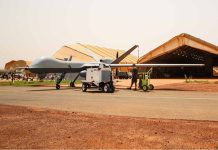

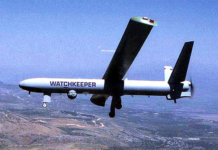

[…] Barry Summers, published on Covert Action Magazine, January 21, […]
[…] Drones to be used to spy on innocent people, https://covertactionmagazine.com/2022/01/21/military-spy-drones-how-domestic-u-s-drone-integration-i… […]
[…] How Domestic U.S. Drone Integration is Propelling Next Wave of Killer Drone Proliferation, by Barry … […]